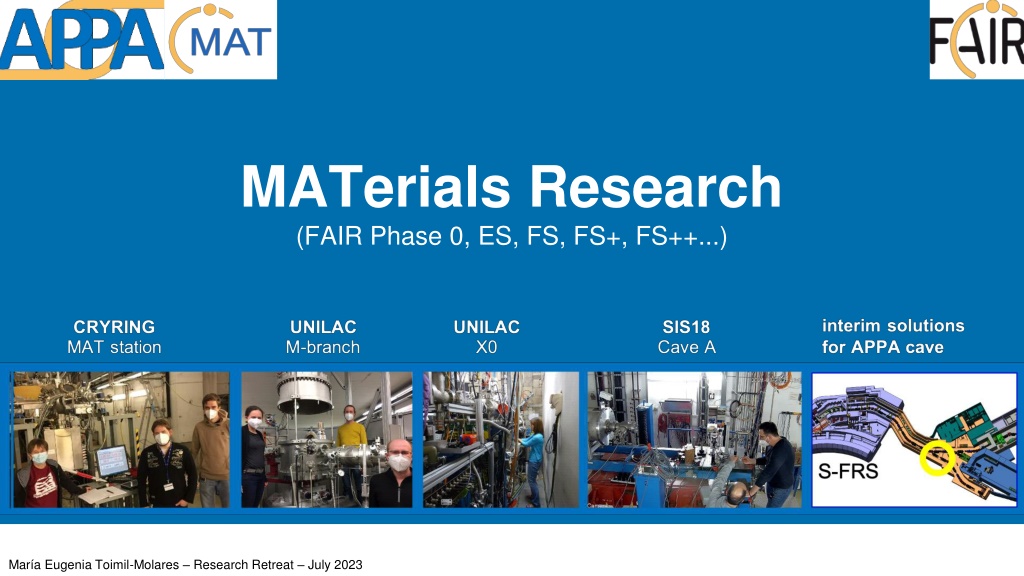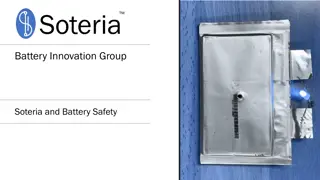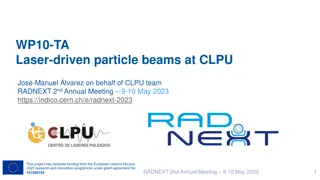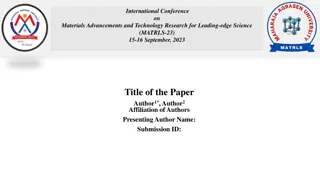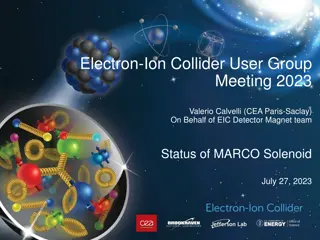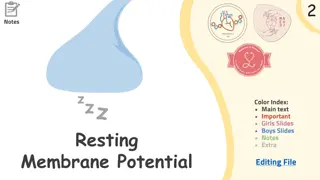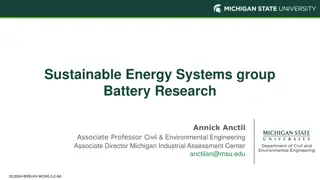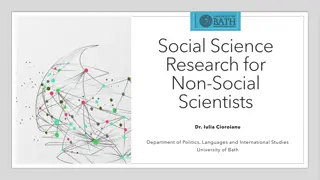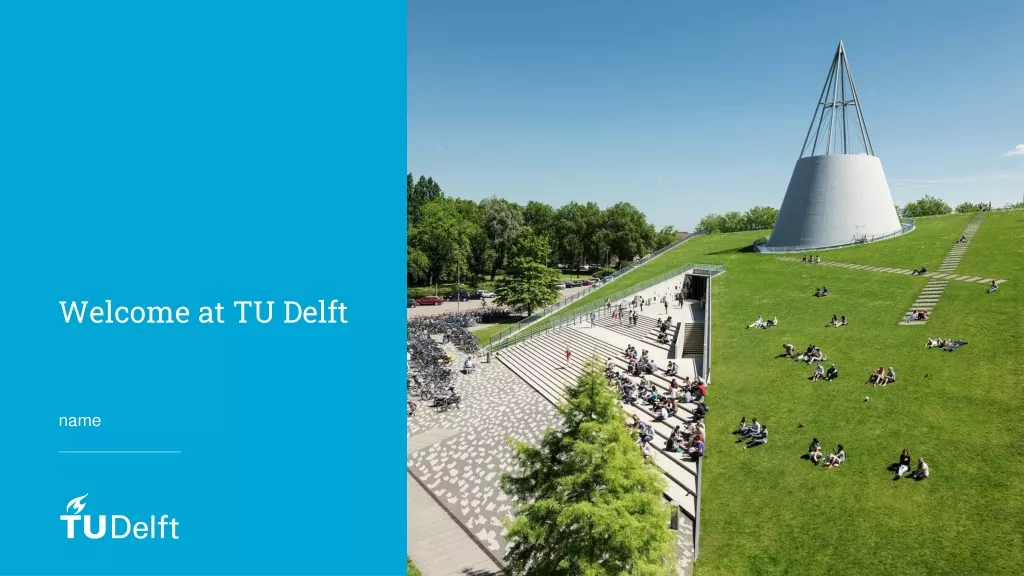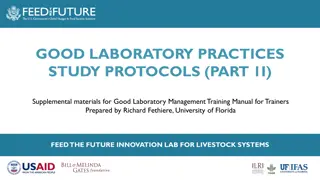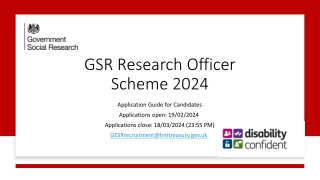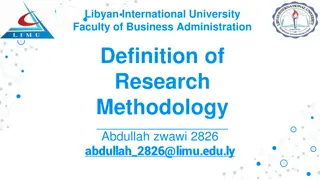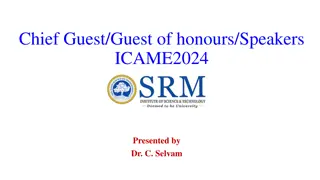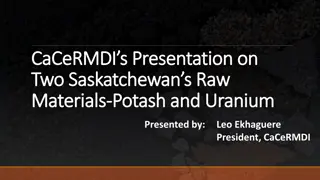Cutting-Edge Swift Heavy Ion Materials Research Retreat
Explore the forefront of materials research with Swift Heavy Ions in a retreat led by Mara Eugenia Toimil-Molares. Activities include studying ion-track nanotechnology, functional membranes, nanowires, and more under extreme conditions. Don't miss the chance to dive deep into the world of complex and quantum materials.
Download Presentation
Please find below an Image/Link to download the presentation.
The content on the website is provided AS IS for your information and personal use only. It may not be sold, licensed, or shared on other websites without obtaining consent from the author. Download presentation by click this link. If you encounter any issues during the download, it is possible that the publisher has removed the file from their server.
Presentation Transcript
MATerials Research (FAIR Phase 0, ES, FS, FS+, FS++...) Mar a Eugenia Toimil-Molares Research Retreat July 2023
Materials Research with Swift Heavy Ions I. Ion-Track Nanotechnology Functional Isoporous membranes Single-nanochannel sensors Size-dependent properties of nanowires Nanowire assemblies for energy applications Activities included in POF Matter MML RT2 (Complex and functional materials, quantum materials)
Materials Research with Swift Heavy Ions I. Ion-Track Nanotechnology II. Heavy-Ion-induced modifications Functional Isoporous membranes Functional materials from bulk Single-nanochannel sensors Space electronics Size-dependent properties of nanowires Nanomaterials to nano Nanowire assemblies for energy applications Molecules ions Activities included in POF Matter MML RT2 (Complex and functional materials, quantum materials)
Materials Research with Swift Heavy Ions I. Ion-Track Nanotechnology II. Heavy-Ion-induced modifications III. Materials under Extreme Conditions Functional Isoporous membranes Functional materials from bulk High-pressure irradiation Single-nanochannel sensors Space electronics Radiation hardness of functional materials Size-dependent properties of nanowires Nanomaterials to nano Nanowire assemblies for energy applications Molecules ions Pressures of up to ~50 GPa Energy loss Ion High Pressure Irradiation Temperature Ion penetration range Activities included in POF Matter MML RT2 (Complex and functional materials, quantum materials)
Materials Research with Swift Heavy Ions I. Ion-Track Nanotechnology II. Heavy-Ion-induced modifications III. Materials under Extreme Conditions Functional Isoporous membranes Functional materials from bulk High-pressure irradiation Single-nanochannel sensors Space electronics Radiation hardness of functional materials Size-dependent properties of nanowires Nanomaterials to nano Nanowire assemblies for energy applications Molecules ions Pressures of up to ~50 GPa Energy loss Ion High Pressure Irradiation Temperature Ion penetration range APPA Cave Cave A MAT-program at existing facilities
Science at existing facilities High energy / ion range Highest ion energy loss SIS18 SIS100 M-branch SIS18 X0 Cave A CBM SIS18 (80-1000 Mev/u) Ion range ~mm-cm UNILAC (3-11.4 MeV/u) Ion range up to 100 m MAT@CRYRING Super-FRS tests of space electronics and materials irradiations at high-pressures radiation hardness of materials ion-track nanotechnology ion-induced materials modifications astrochemistry NUSTAR HEB CRYRING: Highly charged ions at low kinetic energies ion-surface interaction
Facilities MAT Collaboration: ~ 200 collaboration members from 27 countries ~ 40 groups served per beamtime ~ very interdisciplinary (materials science, chemistry, geology, biology, nanosciences, ) Highest ion energy loss Important for MAT collaboration: flexible beam conditions various ion species, energies, fluxes . versatile target stations online and in-situ analysis efficient sample irradiations Large ion penetration range Higher intensities Higher energies Highly charged ions at low kinetic energies Worldwide largest combination of swift heavy ion beams for Materials Research
Materials under extreme conditions SIS100 Cave A Required beams APPA cave SIS18 Higher ion flux > 1e9 U-ions/s no* ? no yes yes yes CBM High intensity pulsed beams APPA cave Higher ion energy Super- FRS NUSTA R HEB Betriebsgenehmigung for all GSI caves *1e9 U-ions/s APPA cave High-pressure irradiation setups Development and testing with SIS-18 beams HED@FAIR SPARC Multipurpose-target station with in- situ and online analytics BIOMAT beamline MAT stations 8
High-pressure irradiation setup I Collimator Raman Head DAC Optical fibers to spectrometer Camera Motorized axes Mobile setup Laser table (1 x 1 m) Prototype setup with online Raman spectroscopy ready Total space: ~ 2 x 3 m2 Further developments in 2023-2025 (collimation, automatic sample exchange system, remote control of motors ) Ready for FAIR day-1 exp Prof. B. Winkler, Bayarjargal, Liang, Merges, Schr ck 9
High-pressure irradiation setup II Paris-Edinburg Cell (PEC) Sample size ~ mm2 Pressure up to ~12 Gpa Tmax~ 600 C Exchange magazine and positioning platform Automatized exchange of inner pressure cell Irradiation and in-situ analysis of up to 12 samples 2023-2025: design, collimation, positioning and cooling systems, Ready for FAIR-day 1 experiments Prof. L. Tacjmanova, Cionoiu, Glasmacher, Blum, Faller (Uni Heidelberg) 10
Radiation hardness setup Multipurpose chamber: Radiation resistant carbon fiber composite windows Remote-controlled sample exchange system In-situ analysis techniques Space: 2 x 1 m2 APPA cave or intermediate locations: New facility to study dynamic response of beam-facing materials on site Fast extraction of high-intensity pulsed beams (intensities up to 1010pps) High energy larger volumes of radiation damaged and thermally excited material Monitoring of ion-pulse induced stress waves Applications: High-power accelerators: targets, collimators, beam windows and beam dumps High temperature reactor materials Space materials Shock and Vibration (2021) 8884447 BMBF VF application in 2024 (Univ. of M nster) 11
Timeline 2028 2027 2025 2024 2030 2026 2029 > 2030 Preparation/ testing of new setups for APPA cave Experimental program of MAT collaboration at existing facilities (UNILAC & HELIAC / SIS 18) X0 Cave A M-branch MAT @ CRYRING Microprobe 12 Mar a Eugenia Toimil-Molares Research Retreat July 2023
Timeline 2028 2027 2025 2024 2030 2026 2029 > 2030 SIS100 APPA Cave Preparation/ testing of new setups for APPA cave Experimental program of MAT collaboration at existing facilities (UNILAC & HELIAC / SIS 18) X0 Cave A M-branch MAT @ CRYRING Microprobe 13 Mar a Eugenia Toimil-Molares Research Retreat July 2023
Timeline > 2030 2028 2027 2025 2024 2030 2026 2029 SIS100 APPA Cave Preparation/ testing of new setups for APPA cave SIS18 SFRS Ring branch SIS100 SFRS Ring branch SIS100 CBM Possibilities for BIOMAT presented to ECE and JSC last June Experimental program of MAT collaboration at existing facilities (UNILAC & HELIAC / SIS 18) X0 Cave A M-branch limited intensity MAT @ CRYRING Microprobe 14 Mar a Eugenia Toimil-Molares Research Retreat July 2023
Intermediate MAT locations in ES/FS/FS+ SIS100 2 possible locations identified SIS18 MAT beam requests: CBM intensities > 1e9 U-ions/s heavy beams (Z Au, preferred U) slow and fast extraction energy range 180 - 500 MeV/u small beam focus < 5 mm Space: 2 x 3 m2 APPA cave Ring-branch @S-FRS 15 Discussions with colleagues A. Senger, P. Gasik, S. Ratschow, H. Simon, and H. Weick are thankfully acknowledged.
Early Science (ES) and FS at ring branch Advantages for MAT: high flux beam available sufficient space available MAT and BIO setups compatible beam focus ~ few mm for 200-600 MeV/u U ions access to SIS-18 and SIS-100 beams S-FRS Ring branch More detailed plans in progress (ECE recommendation): FLUKA calculations for MAT beam parameters local shielding needed? planning of common beamline for BIOMAT access to site for sample exchange or other needs? (it is a tunnel, not a cave ) BIOMAT 16 Mar a Eugenia Toimil-Molares ECE Meeting - May 4th 2023 Mar a Eugenia Toimil-Molares Research Retreat July 2023
Early Science (ES) and FS at ring branch MAT Setup Mobile In preparation BMBF ErUM funded Diagnostic chambers (BIOMAT) MAT Setup Beam dump Planning of common BIOMAT beamline until the next ECE in November 2023: Ionoptic calculations Design of BIOMAT beamline (beamline, diagnostic chambers, instrumentation ) such that they can be transferred to the APPA Cave once it becomes operational. Cost estimate for beamline. In-kind GSI contribution for BIOMAT in APPA Cave: Target handling (1.3.5.2) + Control room (1.3.5.7) + Beamline instrumentation (1.3.5.8) 531 k (in 2005 prices)
Intermediate location in CBM cave SIS100 MAT@CBM: explored as backup option if ring branch would not work CBM Advantages for MAT: high flux beam available before FS++ sufficiently small focus at HADES target position for 400 MeV/u U ion beam. 2 x 2 m2 HP setup Discussions ongoing: FLUKA calculations to estimate MAT experimental conditions that do not affect CBM detector or electronics. 18 Mar a Eugenia Toimil-Molares ECE Meeting - May 4th 2023 Mar a Eugenia Toimil-Molares Research Retreat July 2023
Beamtime requirements in 2026/27 > 2030 2028 2027 2025 2024 2030 2026 2029 SIS100 APPA Cave Preparation/ testing of new setups for APPA cave SIS18 SFRS Ring branch SIS100 SFRS Ring branch SIS100 CBM Possibilities for BIOMAT presented to ECE and JSC last June Continuation of experimental programs at MAT existing facilities (UNILAC / HELIAC / SIS 18) X0 Cave A M-branch MAT @ CRYRING Microprobe 19 Mar a Eugenia Toimil-Molares Research Retreat July 2023
Beamtime requirements in 2026/27 > 2030 2028 2027 2025 2024 2030 2026 2029 SIS100 APPA Cave Preparation/ testing of new setups for APPA cave SIS18 SFRS Ring branch SIS100 SFRS Ring branch SIS100 CBM Possibilities for BIOMAT presented to ECE and JSC last June Continuation of experimental programs at MAT existing facilities (UNILAC / HELIAC / SIS 18) X0 Cave A M-branch MAT @ CRYRING Microprobe 20 Mar a Eugenia Toimil-Molares Research Retreat July 2023
MAT & HELIAC MAT activities would profit from access to HELIAC: stable beam, higher efficiency. MAT research activities at HELIAC at ~ 7 MeV/u. Opportunity for technology transfer: - nanotechnology - heavy ion microprobe for nanostructuring, electronics and detectors tests, Interest in roll production of etched ion-track membranes at GSI expressed by: Jon de Tech pilot line for nanowire plating in Hofstetter PCB Plating in Herrenberg. steel window (10 m) roller device ion beam ion beam (vacuum) air (few cm) Roll irradiation device @ GANIL polymer foil adapted from B. Piquet (2012) https://www.it4ip.be 21 Mar a Eugenia Toimil-Molares Research Retreat July 2023
Summary All MAT activities continue at the current facilities. Activities will profit from access to HELIAC: stable beam, higher efficiency, and possible technology transfer. Materials under extreme conditions experiments require higher ion fluxes than currently available in cave A. In Cave A: limited flux, high-intensity pulsed beams for radiation hardness not possible, and high- pressure irradiations are very inefficient (very long times for fluence accumulation) Temporal locations for MAT prior to APPA cave: Ring branch at S-FRS and CBM cave. Diagnostics and setups for BIOMAT to be transfered to APPA cave as soon as it is available. Addtitional core personnel requested for installation and operation of new FAIR MAT facilities. Very limited lab space. Labs in APPA cave won t be accessible soon. 22 Mar a Eugenia Toimil-Molares Research Retreat July 2023
Summary All MAT-stations will remain in operation as the large variety of ion species as well as a wide range of energies, beam intensities, and analytical tools are essential for the MAT collaboration. Alternative locations for MAT-program in APPA Cave (Materials under extreme conditions): Cave A (HTA): - Limited flux conditions (max. 1e9 ions/s) by the GSI Operating Permit. - High-intensity pulsed beams for radiation hardness tests not possible. - High-pressure irradiations very inefficient (very long times for fluence accumulation). Ring-branch at S-FRS is a very suitable intermediate location. CBM Cave is an alternative in case ring-branch would not work. Ionoptics for E < 400 MeV/u needs to be clarified. Both provide early access to high-flux beams for experiments under multiple extreme conditions. Diagnostics and beamline shared by BIOMAT and covered by in-kind GSI contribution to BIOMAT in APPA cave. Designed to be transferred to APPA cave once it is operational. - - - 25
High pressure Ion Coupling extreme conditions Irradiation Temperature High static pressures Up to 100 GPa Ion Irradiation Energy density ~ eV/atom Pressures of up to ~100 GPa Ion fluence up to 1013i/cm2 GeV heavy ions deposit enormous amount of energy in very localized volumes and in very short times Penetration depth (mm) Diamond anvil cells Formation and stabilization of high-pressure phases - new properties! Study of phases in Earth s & rocky planet s interiors New thermodynamic paths for phase-transitions of bulk materials and nanomaterials PRL (2006) Nature Materials (2009)
MAT Beamtime 2024 / 2025 MAT Beamtime 2024 / 2025 Proposal shifts Granted (A) main Recommended (A-) main sec sec UNILAC SIS18 105 24 169 13 56 17 82 ESR/Cryring/HITRAP 12 27 standard beam conditions UNILAC, M-branch and X0 beamline: Sample irradiations for internal and external user groups ion species: any ions between ~Ca and U 3.6 11.4 MeV/u long pulses (1-4 ms) preferred duty cycle (5 50 Hz) Parallel operation of UNILAC beamlines Mar a Eugenia Toimil-Molares ECE Meeting - May 4th 2023 UNILAC, M-branch and X0 beamline: Sample irradiations for internal and external user groups ion species: any ions between ~Ca and U 3.6 11.4 MeV/u long pulses (1-4 ms) preferred duty cycle (5 50 Hz) 3 27 Mar a Eugenia Toimil-Molares ECE Meeting - May 4th 2023
High-pressure irradiation setup I Raman spectrometer Setup for irradiation of DACs (diamond anvil cells) Ion-induced BI-BIIphase transformation of 35 nm diameter Bi nanowires New nanomaterials properties expected beam collimator 250 m aperture 200-500 MeV/u ions goniometer Beam stops in sample 28
